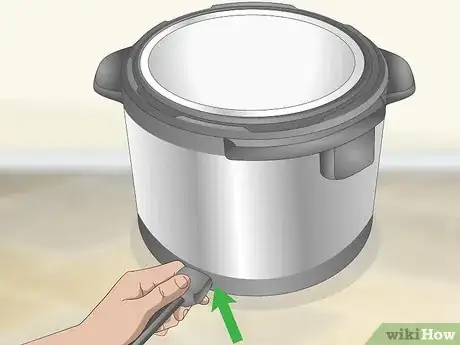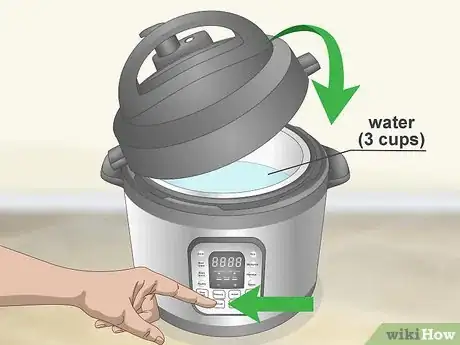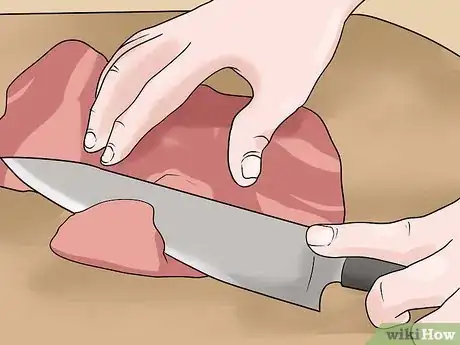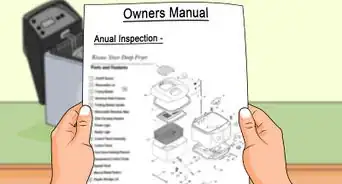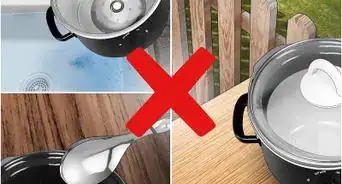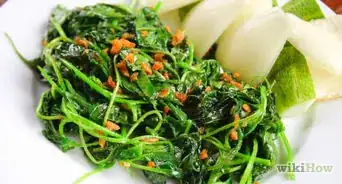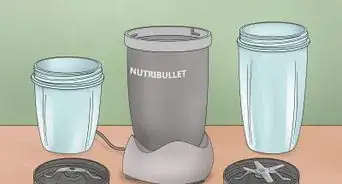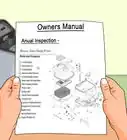This article was co-authored by wikiHow staff writer, Christopher M. Osborne, PhD. Christopher Osborne has been a wikiHow Content Creator since 2015. He is also a historian who holds a PhD from The University of Notre Dame and has taught at universities in and around Pittsburgh, PA. His scholarly publications and presentations focus on his research interests in early American history, but Chris also enjoys the challenges and rewards of writing wikiHow articles on a wide range of subjects.
There are 8 references cited in this article, which can be found at the bottom of the page.
Learn more...
An Instant Pot is a popular kitchen gadget with many great features, but how does it stack up as a slow cooker? Pretty good actually! Just follow our tips and tricks for adjusting slow cooker recipes for an Instant Pot. We’ve also added guidance on converting slow-cook recipes to pressure-cook recipes, and thrown in some tasty recipe ideas as another bonus.
Things You Should Know
- Use a vented glass lid instead of the locking lid to get better slow-cook results with an Instant Pot.
- Low on an Instant Pot equals Keep Warm on a slow cooker, Medium equals Low, and High equals High (but add 15 minutes per hour to the cooking time).
- When converting a recipe, 4 hours (at High heat) of slow cooking is roughly equal to 30 minutes of pressure cooking (at High pressure).
Steps
Slow Cooking in an Instant Pot
-
1Use a vented glass lid for better slow cooking. Yes, you can slow cook with the Instant Pot’s included locking lid. Simply twist the lid to lock it in place (a little chime will play to confirm this) and make sure to set the vent to the open (venting) position. That said, if you plan to slow cook often, invest in a vented glass lid (either one that’s designed for Instant Pot or one that fits correctly) instead.[1]
- A vented glass lid lets steam escape more easily while cooking, which better replicates using a traditional slow cooker. It also lets you see the food during cooking without removing the lid (which is a no-no while slow cooking!).
-
2Prepare your ingredients and add them to the Instant Pot. In nearly every case, you can prep your ingredients exactly according to your recipe, even if it’s a recipe designed for a traditional slow cooker instead of an Instant Pot. There are really only two possible caveats to keep in mind:[2]
- Add some liquid if it’s an unusually dry recipe. Instant Pots only have minimum liquid requirements when pressure cooking, not slow cooking, but they do tend to cook better (even when slow cooking) with at least 8 fl oz (240 ml) of liquid in the pot. Most slow cooker recipes have ample liquid to begin with, but consider adding some water, broth, or juice if your ingredients are on the dry side.
- Don’t fill the pot right up to the top. While the “max” line on the inside of the pot (about 2/3 of the way up) is intended for pressure cooking, not slow cooking, it’s still advisable not to fill the pot nearly to the rim. Because Instant Pots heat from the bottom and have a cylindrical shape, slow-cooked food may be more likely to bubble over. Don’t go much beyond the “max” line, even when slow cooking.
Advertisement -
3Adjust a standard slow cooker recipe’s temperature up a level. An Instant Pot has similar settings to a traditional slow cooker—Low, Medium, and High, compared to Keep Warm, Low, and High. However, the Instant Pot cooks at a lower temperature for each similar setting. So, if you’re using a standard slow cooker recipe (not designed specifically for an Instant Pot), make the following adjustments:[3]
-
Keep Warm (slow cooker) → Low (Instant Pot)
- Instant Pot Low = 170–190 °F (77–88 °C)
-
Low (slow cooker) → Medium (Instant Pot)
- Instant Pot Medium = 195–205 °F (91–96 °C)
-
High (slow cooker) → High (Instant Pot) + 15 minutes per hour[4]
- Add 15 minutes per hour of cooking time on High. So, if the cook time is 2 hours for a traditional slow cooker, it's 2.5 hours for an Instant Pot.
- Instant Pot High = 200–210 °F (93–99 °C)
-
Keep Warm (slow cooker) → Low (Instant Pot)
-
4Use the Slow Cook function on your Instant Pot. All Instant Pot pressure cookers also have a Slow Cook function, but the specific process for using it varies by model. Check your user’s manual or the Instant Pot website for model-specific instructions for slow cooking.
- If you have the Instant Pot Duo (2022), for example:[5]
- Press the Slow Cook button on the panel.
- Use the Temp. Up/Down arrow buttons to adjust to either Low or High power (the default setting is Medium)
- Press the Time Up/Down arrow buttons to adjust the cooking time on the display.
- Press the Keep Warm button (the little light on it will go off) if you don’t want the warming function to come on after the cooking time. Otherwise, it will stay in warming mode for up to 10 hours.
- Press the Start button to begin cooking.
- If you have the Instant Pot Duo (2022), for example:[5]
Pressure Cooking a Slow Cooker Recipe
-
1Use at least 12 fl oz (350 ml) of liquid in your recipe. An Instant Pot is like any other pressure cooker (when used in that mode)—it needs enough water to build up enough steam to increase the internal pressure. A 6 US qt (5.7 L) Instant Pot (or smaller) requires at least 12 fl oz (350 ml) of liquid, while an 8 US qt (7.6 L) model needs 16 fl oz (470 ml) of liquid at minimum. If your slow-cook recipe doesn’t start off with this amount of added liquid, make the adjustment as needed.[6]
- For example, if you want to pressure cook a roast instead of slow cooking it, add 12 or 16 fl oz (350 or 470 ml) of water (or, better yet, beef or chicken broth) to the pot.
- Don’t count any juices or water that will come out of the food while it cooks—you need the minimum amount of liquid right from the start in order to build up steam.
-
2Go with 4 hours (High) = 30 minutes as a general conversion. In other words, 30 minutes of pressure cooking (at High pressure) in an Instant Pot is roughly equivalent to slow-cooking on High for 4 hours. So, if your recipe calls for slow-cooking on High for 6 hours, try pressure-cooking it for 45 minutes.[7]
- The conversion doesn’t work as well for slow-cook recipes set to Low, but you can try a very general guideline of 30 minutes (High pressure) for every 8 hours (Low heat).
-
3Try a food-specific conversion chart for better results. While the 4 hours/30 minutes conversion works fairly well in most cases, you’re better off seeking out recipe-specific conversions. Search online for a slow cooker to Instant Pot conversion chart, or look for recipes that already include the conversion.
- Here’s a conversion example for a whole chicken:[8]
- Slow Cooker: 6-8 hours on Low.
- Instant Pot: 6 minutes (High pressure) per 1 lb (450 g).
- Here’s a conversion example for a whole chicken:[8]
-
4Lock the pressure lid and close the steam vent. Once you’ve added your recipe ingredients (including steam-producing liquid) to the pot, put on the lid with the arrows on the lid and the rim of the device lined up. Turn the lid clockwise until it locks in place—you’ll hear a chime to confirm it’s locked. Turn the steam vent cover (or slide the switch, depending on your model) on the lid to the closed position. Now you’re ready to do some pressure cooking![9]
-
5Follow the specific pressure cook instructions for your model. As Instant Pots become increasingly popular, more and more models hit the market—and the cooking instructions aren’t always the same! While the control panels are fairly intuitive, always follow the instructions for your particular model (available on the Instant Pot site). Here’s how to pressure cook with the Instant Pot Duo (2022), for example:[10]
- Press one of the “smart cooking” buttons (like Rice or Beans/Stew) for preset cooking times (which can be adjusted), or press Pressure Cook to set the cooking time manually.
- Note: This model only cooks at high pressure, but some models offer both low and high pressure. For these models, press either the Pressure Level or Pressure Cook button to toggle between low and high pressure.
- Use the Time up/down arrows to adjust the cooking time displayed on the screen.
- Press the Keep Warm button if you don’t want the warming function to come on after cooking is done (the little light on the button will turn off).
- Push the Start button to begin cooking. The display will show the progress of the steam buildup, then the cooking time remaining.
- While the lid is locked for safety while pressure cooking, never try to force it open while the pot is under pressure.
- Press one of the “smart cooking” buttons (like Rice or Beans/Stew) for preset cooking times (which can be adjusted), or press Pressure Cook to set the cooking time manually.
-
6Opt for a quick release (QR) or natural release (NR) when done cooking. With QR, you twist or slide the pressure vent control on the lid to release the pressurized steam once the cooking time is complete. For NR, simply leave the device alone until the pressure dissipates on its own (the display will confirm this). Recipes designed for Instant Pots nearly always direct you to use either QR or NR, or sometimes a hybrid (such as waiting 10 minutes, then doing a QR).[11]
- Generally speaking, QR is used for foods that overcook quickly, like seafood and veggies. NR, on the other hand, is typically used for starchy foods like pasta and potatoes.
- For safety, keep your hands and face away from the steam release valve when it’s open.
References
- ↑ https://www.cnet.com/home/kitchen-and-household/how-to-convert-slow-cooker-recipes-into-instant-pot-recipes/
- ↑ https://p.widencdn.net/etsj7m/IB_112-0212-01_Duo-V6-Unibody-6QT_User-Manual_US_FINAL_LowRes_070122.pdf, p. 27
- ↑ https://www.cnet.com/home/kitchen-and-household/how-to-convert-slow-cooker-recipes-into-instant-pot-recipes/
- ↑ https://thecookful.com/should-you-use-instant-pot-as-slow-cooker/
- ↑ https://p.widencdn.net/etsj7m/IB_112-0212-01_Duo-V6-Unibody-6QT_User-Manual_US_FINAL_LowRes_070122.pdf, p. 27
- ↑ https://p.widencdn.net/mi7wmd/112-0169-01_IB_DuoPlusV4_6QT_US_Manual_FINAL_LowRes_11-15-22.pdf, p. 25
- ↑ https://www.cnet.com/home/kitchen-and-household/how-to-convert-slow-cooker-recipes-into-instant-pot-recipes/
- ↑ https://kidsactivitiesblog.com/119008/printable-slow-cooker-instant-pot-conversion-chart/
- ↑ https://p.widencdn.net/etsj7m/IB_112-0212-01_Duo-V6-Unibody-6QT_User-Manual_US_FINAL_LowRes_070122.pdf, p. 20
